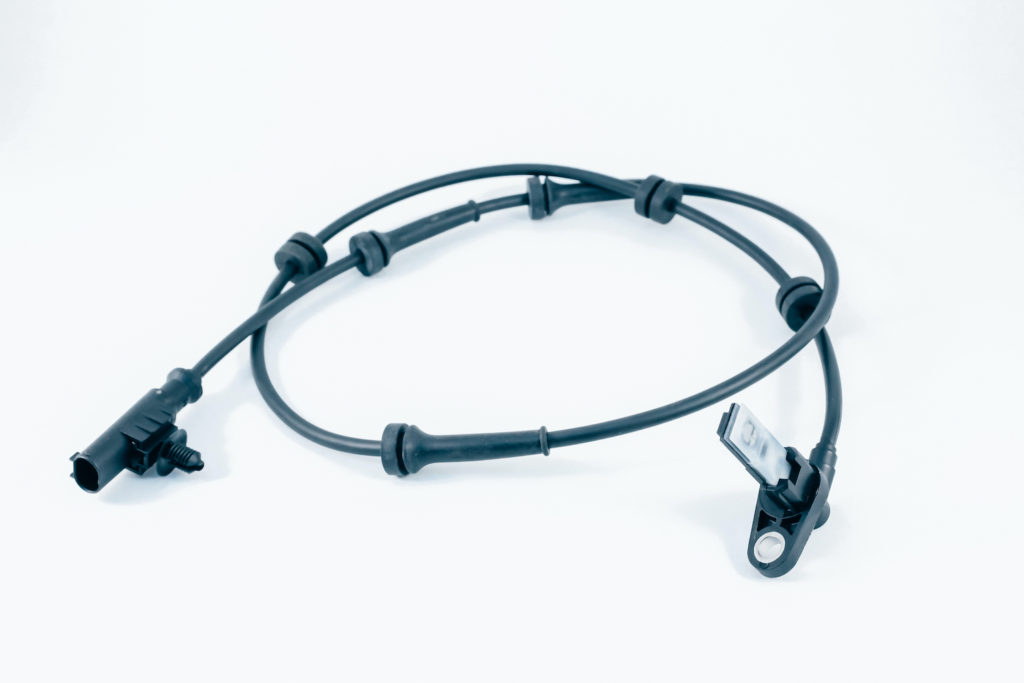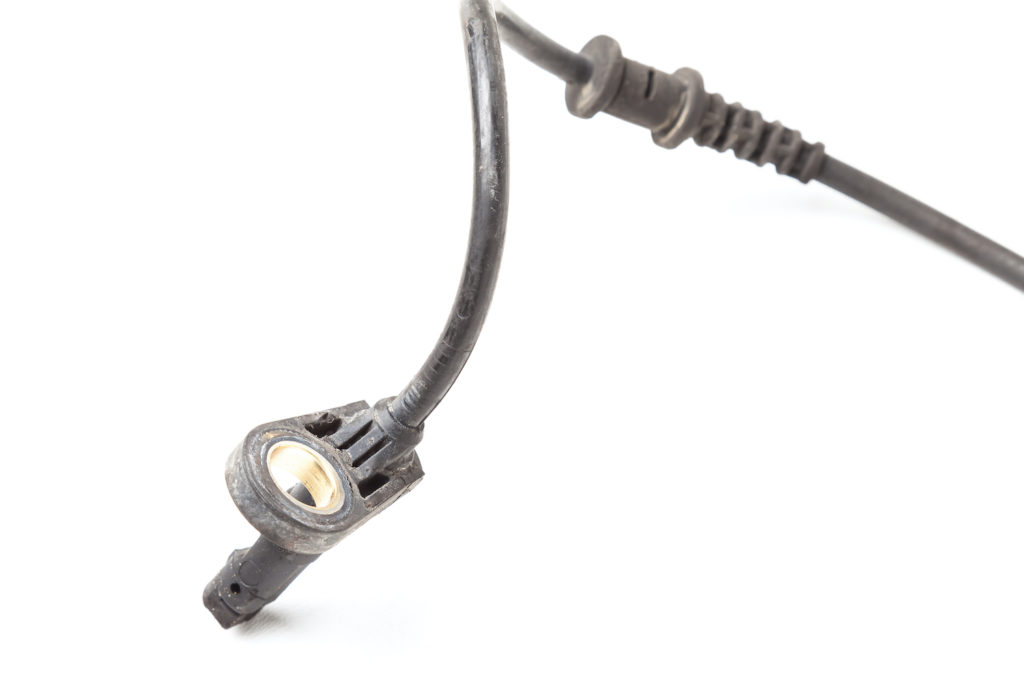You’re driving down the road when suddenly, the antilock brake system (ABS) warning light pops up on the dashboard. Although an illuminated ABS light can mean many things, the most common cause of the warning is a faulty ABS sensor.
The good news is, replacing an ABS sensor is usually a straightforward task. In most cases, all you need to complete the job is a jack, jack stands, and basic hand tools.

What is an ABS Sensor?
Since 2004, ABS has been required on all new vehicles sold within the United States. The technology modulates fluid pressure to the brakes to prevent wheel lockup during a panic stop. The ABS sensors play a vital role in ABS operation.
Most late-model cars have an ABS sensor (also known as a wheel speed sensor) at each wheel. Each ABS sensor measures wheel speed by reading a toothed reluctor ring on the axle or hub assembly. The sensors then relay that information back to a computer, typically referred to as the ABS control module.
When the ABS speed sensors indicate wheel lockup is about to occur, the ABS control module will regulate brake fluid pressure to the affected wheels. Normal brake operation will occur once traction is regained.
Although most modern vehicles have four ABS sensors (one at each wheel), there are also single-channel ABS systems that have just one sensor. The sensor is mounted on the transmission or differential to prevent rear-wheel lockup.
There are also three-channel systems that have two speed sensors in the front and one in the rear. Two of the sensors are at the front wheels, while the other is mounted to the transmission or differential.

How to Test an ABS Sensor
A variety of problems can mimic a bad ABS sensor, so it’s a good idea to test a suspect part before you rush out and buy a new one.
Before getting started, however, you’ll want to have the vehicle’s repair information handy. Manuals, such as those from Chilton, are good, but a subscription to a repair database (e.g., ALLDATA or Mitchel 1 DIY) is even better. You can find more information on accessing quality repair information in our article on repair manuals.
Note: The following are general guidelines for educational and entertainment purposes only. Consult your vehicle’s factory information for specific repair instructions and recommended safety procedures.

Step 1. Check Diagnostic Trouble Codes (DTCs) and Live Data
The ABS module monitors the ABS sensors and their corresponding circuits. If the module detects a problem with one or more of the sensors, it will store a diagnostic trouble code (DTC) in its memory and turn on the ABS warning light.
If you suspect a bad ABS sensor, the first step in the diagnostic process is to check for DTCs. You can retrieve DTCs with a quality scan tool or code reader. Most inexpensive code readers will not read ABS codes, so you’ll need to shop around to find a tool that does.
Usually, if there’s a problem with one of the ABS sensor circuits, the DTCs will help you determine which one is having issues. For example, you may find codes for the “left front wheel speed sensor circuit” or right front wheel speed sensor circuit”. Codes, such as these, will help you figure out which sensor is acting up.
Some scanners also display ABS live data that allows you to monitor ABS sensor operation while an assistant drives the vehicle. If there’s a fault with a particular sensor or its circuit, that sensor will display a different value than the others.
This video will give you an idea of what type of information a scan tool can provide:
Note: Just because the scan tool codes and data indicate a problem with a particular speed sensor, that doesn’t necessarily mean the issue is with the sensor itself. There could be something wrong with the sensor’s circuit or reluctor ring preventing the sensor from reading properly.
Step 2. Perform a Visual Inspection
Next, you can move on to performing a visual inspection. You’ll want to look for issues, such as damaged wires and poor connections. Make sure that the ABS sensor’s electrical connector is clean and tight.
Repair any issues found during the visual inspection, clear the DTCs, and see whether the problem returns.
Step 3. Test the ABS Sensor Directly
Testing an ABS sensor can be tricky. There are two primary types of ABS sensors: passive and active. Passive sensors output an alternating current (AC) voltage frequency signal, while active sensors create a square wave digital signal. It’s important to know what type of sensor your car has.
You can distinguish between the two types of sensors by noting that passive ABS sensors have two wires, whereas active sensors usually have three wires. Consult a repair manual or repair database if you don’t know what type of sensor your car has.
It’s best to test the ABS sensor’s output signal with an oscilloscope. However, most DIYers only have access to a digital multimeter (DMM). You can use a DMM to check an ABS sensor’s output signal, though the results can sometimes be misleading.
Also, in some instances, the vehicle manufacturer will specify resistance values for passive-style wheel speed sensors. You can check the resistance of an ABS sensor with a DMM turned to the ohms setting, then compare that value to the specifications found in a repair manual or repair database.
The video below demonstrates testing a passive ABS sensor with a DMM:
And this video gives you an idea of what’s involved with testing an active ABS sensor:
ABS Sensor Replacement How-To
Like any automotive part, an ABS sensor can eventually fail. When that happens, you’ll want to swap out the faulty sensor for a new one.
The ABS sensor replacement process will vary, depending on the year, make, and model of the vehicle. So, before you jump right in, it’s a good idea to consult the instructions for your application in a repair manual or repair database.
Below, you’ll find a general overview of what’s typically involved with replacing an ABS sensor.
Tools and Equipment Needed to Replace an ABS Sensor
The tools needed to replace an ABS sensor will vary, depending on the type of car you have.
In general, however, you’ll need:
- Jack and jack stands
- Ratchet and socket set
- Repair manual or access to a repair database
- Safety glasses
- Torque wrench
- Wheel chocks

ABS Sensor Replacement Instructions
Replacing an ABS sensor is usually a fairly straightforward task. The following steps will give you an idea of what the job usually involves.
Note: The following are general guidelines for educational and entertainment purposes only. Consult your vehicle’s factory information for specific repair instructions and recommended safety procedures.
ABS Sensor Removal
- Put on your safety glasses.
- Disconnect the negative battery cable.
- Safely raise and support the vehicle using a jack and jack stands. Set the parking brake and chock the rear wheels.
Disconnect the electrical connector from the ABS sensor harness. - Use a ratchet to remove the ABS sensor retaining bolt. You’ll also want to remove any fasteners holding the sensor’s wiring harness in place.
- Remove the ABS sensor from the vehicle.
ABS Sensor Installation
- Compare the new ABS sensor to the old ABS sensor to ensure that both are the same design.
- Install the new ABS sensor.
- Reinstall the ABS sensor retaining bolt, along with any wiring harness retaining fasteners. Use a torque wrench to tighten all fasteners to the manufacturer’s specification.
- Reconnect the ABS sensor electrical connector.
- Safely remove the jack stands and lower the vehicle.
- Reconnect the negative battery cable.
- Use a scan tool or code reader to clear any related diagnostic trouble codes (DTCs).
Here are some videos that demonstrate what an ABS sensor replacement typically involves:
Can You Drive With a Bad ABS Sensor?
Technically, you can continue to drive with a bad ABS sensor—but your car’s ABS system won’t work properly. That’s why, to keep your vehicle as safe as possible, you should replace a faulty ABS sensor right away.
Get an ABS Sensor Delivered to Your Doorstep
Avoid driving your car until you have replaced its faulty ABS sensor. It’s unsafe to drive with a bad anti-lock brake sensor, especially if rain or snow turns the roads slippery. Get your car back on the road quickly with a replacement ABS sensor from CarParts.com.
CarParts.com delivers the ABS sensor you need to where you need it. When you order from us, we process your order from the nearest distribution center and ship your new part to your home. If you live anywhere in the continental US and order by noon ET, you can expect your replacement ABS sensor to reach your home in several business days. We ensure that you get the performance and reliability you deserve by exclusively sourcing our products from trusted manufacturers. Got any questions about our products? Our helpful customer service team is always available.
Get great discounts on high-grade anti-lock brake sensors at CarParts.com. Browse our selection of ABS sensors and order what you need today.
Any information provided on this Website is for informational purposes only and is not intended to replace consultation with a professional mechanic. The accuracy and timeliness of the information may change from the time of publication.


























